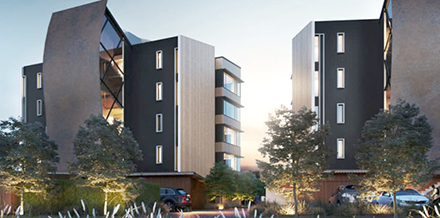Design funding is available for qualifying yet-to-be-built wooden buildings as part of a partnership between the New Zealand Ministry of Primary Industries and Red Stag. Funding of several hundred thousand dollars is potentially available for a select number of projects that quality for the scheme, according to Red Stag group CEO Marty Verry. Source: Timberbiz
“What we are trying to do with MPI is showcase different types of mid-rise wooden structures that push the boundaries in terms of scale or height. As part of that, we want to share the knowledge and design with the New Zealand design and construction sector,” he said.
“Typically, this will involve open sourcing of design reports, site visits and case study write-ups.
“We’re looking for demonstration projects such as 6-plus level apartments or aged care, mid-rise office buildings, large format retail, industrial or warehouse projects, as well as educational and cultural projects that are going to be constructed in the next two years.”
The program is part of the ‘Mid-Rise Wood Construction’ partnership between Red Stag and MPI, originally set up under the Primary Growth Partnership scheme.
The scheme is connected to the government’s initiatives to deliver a zero-carbon construction sector by designing out carbon intensive materials used in construction.
“This ‘Embodied Carbon’, as it is known, is estimated by the Green Building Council to account for 10% of New Zealand’s CO2 emissions, mainly in the form of steel and concrete usage” Mr Verry said.
“With the development in recent decades of products such as Cross Laminated Timber (CLT) and glulam, it is now possible to eliminate Embodied Carbon in New Zealand’s buildings.”
The demonstration building program is already underway with its first project in Christchurch (picturd), a five-storey apartment development built in CLT, LVL and pre-fabricated timber walls.
More than 120 developers, engineers and architects poured over the building under construction in May and heard the quantity surveyor findings that the wood solution was cost comparable with high emission materials such as steel and concrete, yet it was carbon negative.
More open days are planned for late October.
“The objective is to educate and prepare the New Zealand design community for the changes government will be making with its ‘Building for Climate Change’ program next year,” Mr Verry said.
“Those designing for government departments will also benefit, as they need to comply with the recently- announced procurement requirement to select the lowest carbon design option available.
“We welcome anyone with potential demonstration projects in the pipeline to get in touch.”








